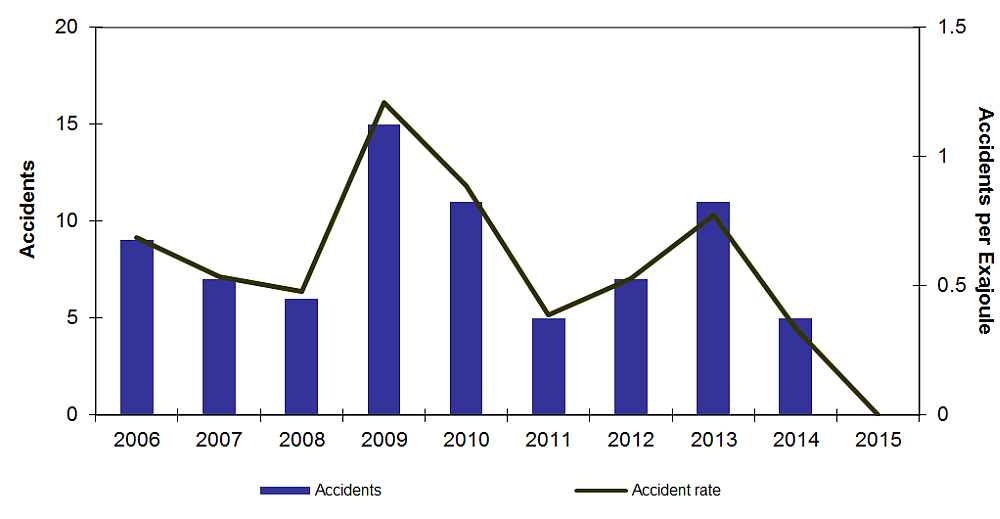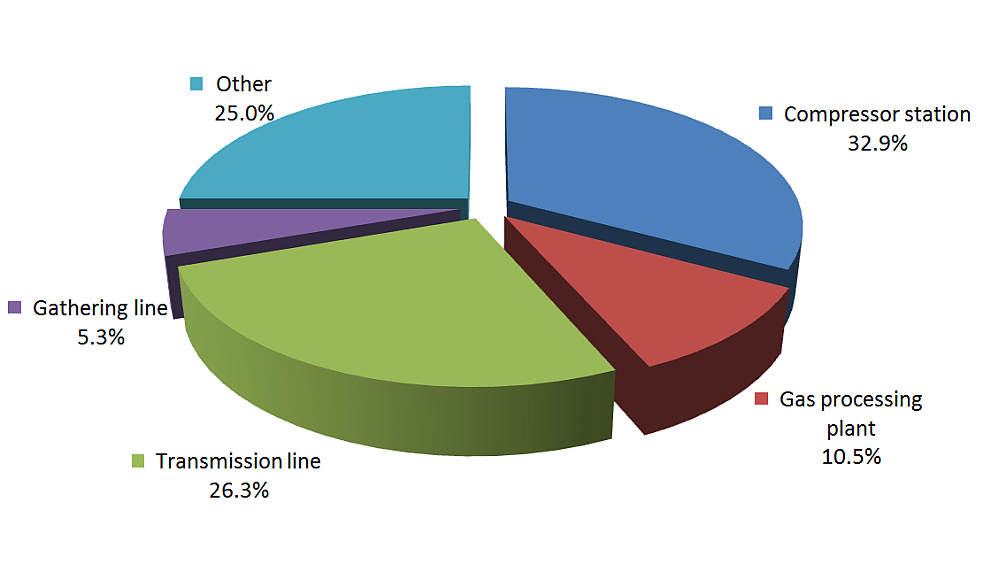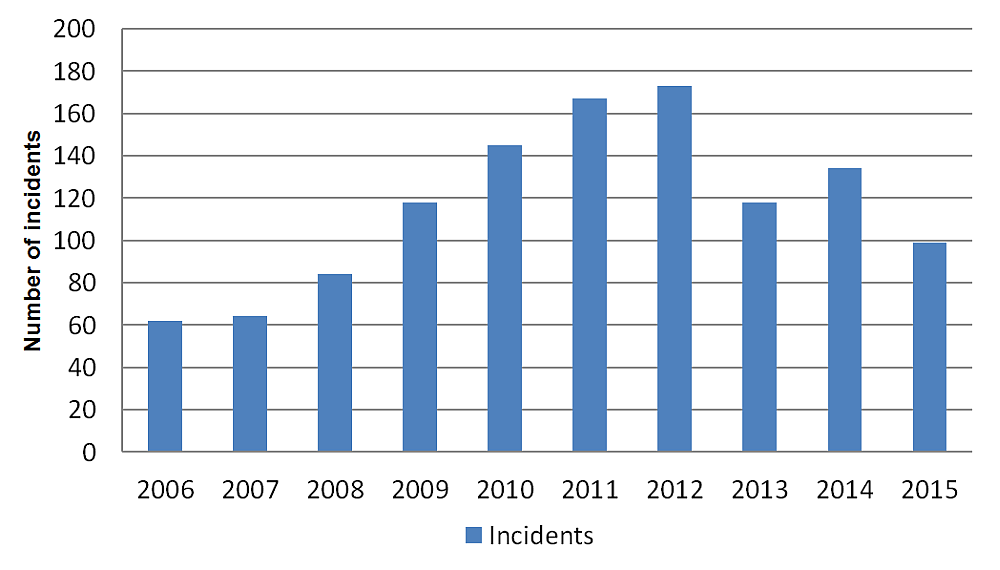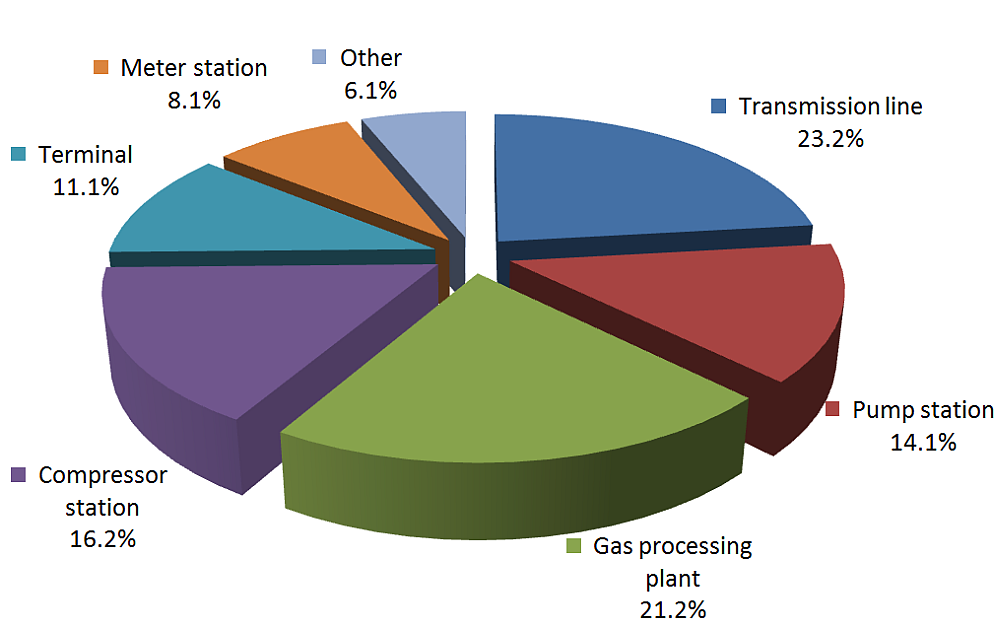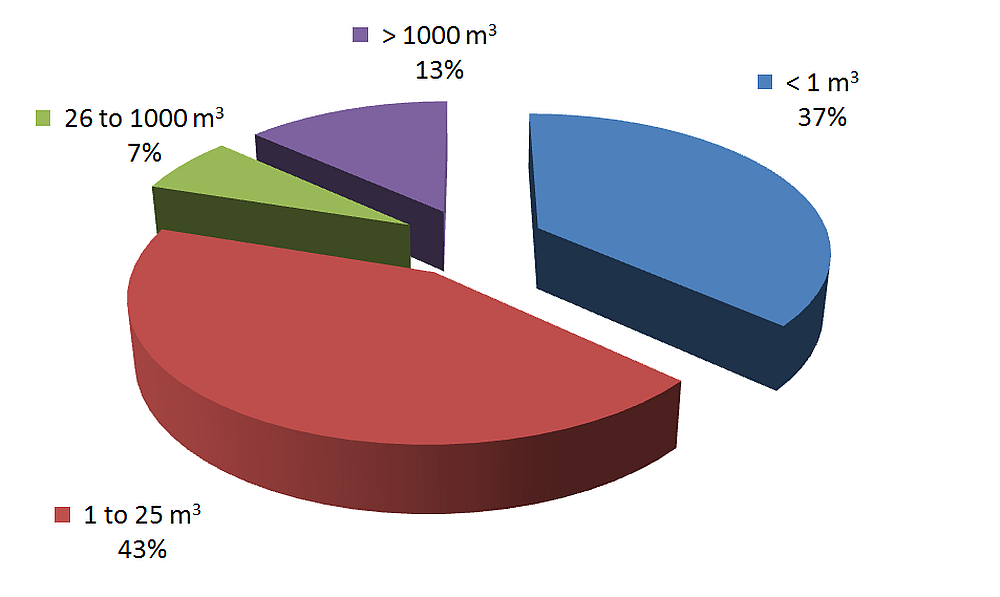Foreword
This document is a summary of selected 2015 pipeline safety data. It covers federally regulated pipelines only. Data concerning non-federally regulated pipelines reported to the TSB are not included in this report.
The TSB gathers and uses this data during the course of its investigations to analyse safety deficiencies and identify risks in the Canadian transportation system.
The 2015 data were collected according to the reporting requirements described in the TSB Regulations in force during that calendar year.
The statistics presented here reflect the TSB database at 17 February 2016. Since the occurrence data are constantly being updated in the live database, the statistics may change slightly over time.
Because many occurrences are not formally investigated, information recorded on some occurrences may not have been verified. Consequently, be cautious in using these statistics.
The following data tables are associated with the Statistical Summary – Pipeline Occurrences 2015.
- Pipeline accidents and incidents by type, 2006–2015
- Pipeline activity and accident rate, 2006–2015
- Pipeline accidents and incidents by province, 2006–2015
- Pipeline accidents and incidents by facility type, 2006–2015
- Pipeline accidents and incidents with released by product type, 2006–2015
- Pipeline accidents and incidents by quantity released, 2006–2015
The federally regulated pipeline system
In 2015, in the federally regulated pipeline system,
- 38 companies, including 11 that transport both oil and gas, transported 217 million cubic metres (m3) of oil (1.4 billion barrels) along 21 637 kilometres of oil pipelines;
- 65 companies, including the 11 that transport both oil and gas, transported 152 billion cubic metres of natural gas (5.5 trillion cubic feet) along 56 332 kilometres of natural gas pipelines.Footnote 1
Accidents
Overview of accidents
No pipeline accidents were reported to the TSB in 2015,Footnote 2 down from a total of 5 in 2014 and down from the annual average of 8 in the previous 5 year period (2010 to 2014).
Pipeline activity increased 1% from 2014.Footnote 3 A general indicator of pipeline transportation safety in Canada is the pipeline accident rate. The 2015 rate was 0 pipeline accidents per exajoule,Footnote 4 down from 0.3 in 2014, and down from the annual average of 0.6 in 2010 to 2014 (Figure 1).
Figure 1 data table
| Year | Accidents | Accident rate |
|---|---|---|
| 2006 | 9 | 0.687022901 |
| 2007 | 7 | 0.534351145 |
| 2008 | 6 | 0.48 |
| 2009 | 15 | 1.209677419 |
| 2010 | 11 | 0.887096774 |
| 2011 | 5 | 0.387596899 |
| 2012 | 7 | 0.527601073 |
| 2013 | 11 | 0.774647887 |
| 2014 | 5 | 0.333555704 |
| 2015 | 0 | 0 |
Location of accidents
Over the past 10 years (2006–2015), 43.4% of pipeline accidents occurred at compressor stations and gas processing plants, and 26.3% occurred on transmission lines (Figure 2). The remaining pipeline accidents (30.3%) occurred at pump stations, terminals, meter stations, and on gathering lines.
Figure 2 data table
| Facility type | Number | Percentage |
|---|---|---|
| Compressor station | 25 | 32.9 |
| Gas processing plant | 8 | 10.5 |
| Transmission line | 20 | 26.3 |
| Gathering line | 4 | 5.3 |
| Other | 19 | 25 |
Fatalities
There have been no fatal accidents on a federally regulated pipeline system directly resulting from the operation of a pipeline since the inception of the TSB.
Release of product
Although no accidents were reported in 2015, over the past 10 years (2006 to 2015), 41 of the 76 occurrences identified as accidentsFootnote 6 resulted in a release of product. Natural gas was released in 20 accidents, with 6 releases of less than 1 cubic metre, 2 releases between 1 and 25 cubic metres, 2 releases between 26 and 1000 cubic metres, and 10 releases over 1000 cubic metres. Crude oil was released in 13 accidents, with 8 releases of less than 1.5 cubic metre (9.44 barrels (bbl)), 1 release between 1.5 and 25 cubic metres (between 9.44 barrels and 157 bbl), 3 releases between 26 and 1000 cubic metres (between 157 and 6290 bbl), and 1 release over 1000 cubic metres (6290 bbl).
Incidents
Overview of incidents
In 2015, 99 pipeline incidentsFootnote 7,Footnote 8 (Figure 3) were reported to the TSB, down from 134 in 2014 and down from the annual average of 147 in the previous 5 years (2010 to 2014). With the new TSB Regulations in effect starting 1 July 2014, there was a decrease in the number of reported incidents involving releases of low vapour pressure hydrocarbons from that date to the end of 2015.
Figure 3 data table
| Year | Incidents |
|---|---|
| 2006 | 62 |
| 2007 | 64 |
| 2008 | 84 |
| 2009 | 118 |
| 2010 | 145 |
| 2011 | 167 |
| 2012 | 173 |
| 2013 | 118 |
| 2014 | 134 |
| 2015 | 99 |
Location of incidents
In 2015, 23.2% of pipeline incidents occurred on transmission lines, followed by 21.2% at gas processing plants, 16.2% at compressor stations, 14.1% at pump stations, 11.1% at terminals, and 8.1% at meter stations. The remaining incidents occurred on gathering lines, or at other facilities (Figure 4).
Figure 4 data table
| Facility type | Number | Precentage (%) |
|---|---|---|
| Transmission line | 23 | 23.2 |
| Pump station | 14 | 14.1 |
| Gas processing plant | 21 | 21.2 |
| Compressor station | 16 | 16.2 |
| Terminal | 11 | 11.1 |
| Meter station | 8 | 8.1 |
| Other | 6 | 6.1 |
Release of product
In 2015, 30% of the incidents involved no release of product and 23% of the incidents involved a release of less than 1 cubic metre of natural gas, oil, other petroleum product, or non-petroleum product (e.g., sulphur). Three incidents involved a release of 1.5 to 25 cubic metres (between 9.44 and 157 bbl) of crude oil. Thirteen incidents involved a release of 26 to 1000 cubic metres of natural gas, and 4 incidents involved a release of over 1000 cubic metres of natural gas. Three incidents involved a release of 1 to 25 cubic metres of sour gas, and 5 involved a release of 26 to 1000 cubic metres of sour gas (Figure 5).
Figure 5 data table
| Released quantity | Number | Percentage |
|---|---|---|
| < 1 m³ | 11 | 37 |
| 1 to 25 m³ | 13 | 43 |
| 26 to 1000 m³ | 2 | 7 |
| > 1000 m³ | 4 | 13 |
For reportable occurrences, natural gas releases of less than 1 cubic metre decreased to 11 in 2015 (16% of all product releases) from 29 in 2014 (28% of all product releases).
Crude oil releases of 1.5 cubic metres or more (9.44 barrels or more) decreased from 7 in 2014 to 3 in 2015.
Definitions
Pipeline accidents and incidents before 1 July 2014
Prior to July 2014 (previous TSB Regulations), pipeline accidents and incidents are defined as follow:
Pipeline accidents
“Reportable commodity pipeline accident” means an accident resulting directly from the operation of a commodity pipeline, where
- a person sustains a serious injury or is killed as a result of being exposed to
- a fire, ignition or explosion, or
- a commodity released from the commodity pipeline, or
- the commodity pipeline
- sustains damage affecting the safe operation of the commodity pipeline as a result of being contacted by another object or as a result of a disturbance of its supporting environment;
- causes or sustains an explosion, or a fire or ignition that is not associated with normal operationg circumstances; or
- sustains damage resulting in the release of any commodity.
Pipeline incidents
“Reportable commodity pipeline incident” means an incident resulting directly from the operation of a commodity pipeline, where
- an uncontained and uncontrolled release of a commodity occurs,
- the commodity pipeline is operated beyond design limits,
- the commodity pipeline causes an obstruction to a ship or to a surface vehicle owing to a disturbance of its supporting environment,
- any abnormality reduces the structural integrity of the commodity pipeline below design limits,
- any activity in the immediate vicinity of the commodity pipeline poses a threat to the structural integrity of the commodity pipeline, or
- the commodity pipeline, or a portion thereof, sustains a precautionary or emergency shut-down for reasons that relate to or create a hazard to the safe transportation of a commodity.
Pipeline occurrences after 1 July 2014
On 1 July 2014, the new reporting provisions of the TSB Regulations came into effect. According to section 4(1) of the TSB Regulations, the operator of a pipeline must report the following pipeline occurrences to the Board if they result directly from the operation of the pipeline:
- a person is killed or sustains a serious injury;
- the safe operation of the pipeline is affected by
- damage sustained when another object came into contact with it, or
- a fire or explosion or an ignition that is not associated with normal pipeline operations;
- an event or an operational malfunction results in
- an unintended or uncontrolled release of gas,
- an unintended or uncontrolled release of HVP hydrocarbons,
- an unintended or uncontained release of LVP hydrocarbons in excess of 1.5 m3, or
- an unintended or uncontrolled release of a commodity other than gas, HVP hydrocarbons or LVP hydrocarbons;
- there is a release of a commodity from the line pipe body;
- the pipeline is operated beyond design limits or any operating restrictions imposed by the National Energy Board;
- the pipeline restricts the safe operation of any mode of transportation;
- an unauthorized third party activity within the safety zoneFootnote 9 poses a threat to the safe operation of the pipeline;
- a geotechnical, hydraulic or environmental activity poses a threat to the safe operation of the pipeline;
- the operation of a portion of the pipeline is interrupted as a result of a situation or condition that poses a threat to any person, property or the environment; or
- an unintended fire or explosion has occurred that poses a threat to any person, property or the environment.
Pipeline accidents after 1 July 2014
For 2014 statistical reporting, pipeline accidents as of 1 July 2014 consist of reportable pipeline occurrences that resulted in
- loss of human life;
- a serious injury;Footnote 10
- a fire or explosion that causes a pipeline or facility to be inoperative;
- a low vapour pressure hydrocarbon release in excess of 1.5 m³ that leaves company property or the right-of-way;
- a rupture;Footnote 11 or
- a toxic plume.Footnote 12
Pipeline incidents after 1 July 2014
For 2014 statistical reporting, pipeline incidents as of 1 July 2014 consist of all reportable pipeline occurrences other than pipeline accidents.
Footnotes
Footnote 1The size of the federally regulated pipeline system, the number of companies, and the volumes of product transported were provided by the National Energy Board (NEB).
Footnote 2Refer to Definitions below for the definition of pipeline accidents. The 2015 Statistical Summary is the first full year of data following the change in the definitions of pipeline accidents and incidents, which occurred in July 2014.
Footnote 3Pipeline activity is provided by the National Energy Board (NEB).
Footnote 4One exajoule = 1018 joules (A joule is a unit of work or energy equal to the work done by a force of one newton acting through a distance of one metre.)
Footnote 5Source: NEB (estimated).
Footnote 6A change in the definition of pipeline accidents occurred in July 2014.
Footnote 7New TSB Regulations came into effect on 1 July 2014. Under the new reporting requirements, unintended or uncontained releases of low vapour pressure hydrocarbons from pipelines are only reportable if they are in excess of 1.5 m3 in volume.
Footnote 8See Definitions below.
Footnote 9“Safety zone” means the area extending 30 m perpendicularly from the centre of a pipeline on either side of the pipeline.
Footnote 10As defined in the Transportation Safety Board Regulations.
Return to footnote 10 referrer
Footnote 11An instantaneous release that immediately impairs the operation of a pipeline such that pressure cannot be maintained.
Return to footnote 11 referrer
Footnote 12As defined in Canadian Standards Association Standard Z662.
